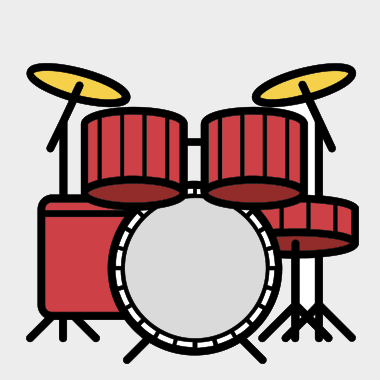 Vocal percussion is imitating drums and percussion with the voice. This technique was developed in the eighties in hiphop music and in that music style, it’s called beatboxing. In the a cappella world however, it is called vocal percussion.
Vocal percussion is imitating drums and percussion with the voice. This technique was developed in the eighties in hiphop music and in that music style, it’s called beatboxing. In the a cappella world however, it is called vocal percussion.
Basic sounds
The basic instruments for a pop groove are the bass drum for the low sounds, the snare drum for the mid high sounds and the hihat for the high for the high sounds. A typical groove looks like this:
The snare drum is played on the second and fourth beat. The accents on those beats are called the backbeat. The bass drum is used on the beats where the snare drum is not sounding and in between the beats. The hihat is mostly used for the eighth notes or sixteenths notes.
The snare drum
The most important instrument for the groove is the snare drum. A drummer can play the snare in several ways. Below are the three sounds that are used most often.
Rim click
For the rim click the drummer is ticking on the side of snare drum with the stick, while at the same time holding the other side of the stick on the skin of the drum. This rim click is rather soft and it’s used in particular in ballads. This kind of sound is easy to imitate, using a loud, unvoiced k.
Snare and rimshot
For this sound, the drummer is hitting on the skin of the drum (optionally hitting the side of the drum at the same time). These sounds are quite hard to imitate in a good way. Most vocal percussionists make a loud p, using a lot of lip tension, followed by a short ff. Optionally you might use sh instead of ff. Try to make the p as sharp as you can and the transition between both sounds as quickly as possible.
Synthesizer snare
An alternative way to imitate the snare is first to make a small cough and then a sh. This sound resembles a more electronically produced sound.
The bass drum
In vocal percussion the imitation of the bass drum should be as low as possible. The best method for making this sound is depending on whether you are using a microphone or not.
With microphone
If you are using a microphone, you can imitate the bass drum by making a relaxed, voiceless p, letting it “plop” Try to form the vowel oh with your mouth. Hold the mike to your mouth and enclose the head of the microphone with your hands. The “plop” will cause the membrane to shut and this will cause a good sound for the bass drum.
Without microphone
If you don’t have a microphone, a voiceless p is too soft. This means you have to use a voiced sound, like dm or dvv. This kind of technique sounds is easier to make for men than for women, because men’s voices are generally an octave lower.
The hihat
The sound of the hihat is relatively easy to imitate, using a voiceless t. Try to make the sound as high as possible and make sure it’s dry, i.e. there is not sounding an h or s in addition.
Often the hihat is too loud in comparison to the other sounds. Make sure it always is considerably softer than the backbeat. This means you should hold back in the hihat and give a lot of energy on the backbeat.
In pop grooves, you can use the sound of an open hihat as a variation. In that case, the drummer is letting the cymbals ring apart, creating a long sound. You can imitate this sound with a long tss. Don’t make the ss too high, but instead let it lisp a little.
Other drum and percussion sounds
Crash cymbal
The crash is a long high accent on the cymbals, used by the drummer at the start of periods (for example, each sixteen or thirty-two bars). Good sounds for the crash are k-shsh or shsh preceded by a cough.
Tomtoms
These are small drums with different heights, used in fills. Good sounds for these instruments are d-uh-b or d-vv with the teeth together. Use the voiced uh or vv to create different heights.
Shaker
You can easily imitate a shaker on ch-k-ch-k.
Microphone
Vocal percussion sounds especially nice if you are using a mike. In this way, the bass can sound really low, because you can use the special technique described above. Furthermore, the microphone ensures the character of the sounds will be truly percussion-like. You can make the drumming sound even more interesting, by using equalising. Soften the mid frequencies and boost the low and mid high frequencies.
If on stage you are using a microphone for vocal percussion, make sure you practice a lot with microphone, because it is demanding for a different technique.
Make sounds interesting
Drum sounds have a strong attack and decay quickly. That’s why you should make the sounds short and intense. Furthermore, try to avoid clear vowels. Vocal percussion sounds especially interesting if they lie far from the regular human language.
The sounds of beatboxing can be created in a lot of different ways. Each vocal percussionist has a personal style. The methods described above are thus intended as a starting point. Through practice, you will discover what methods suit you to create the best sounds.